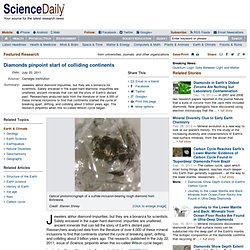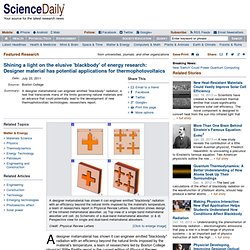

Exercise has numerous beneficial effects on brain health and cognition, review suggests. It's no secret that exercise has numerous beneficial effects on the body.

However, a bevy of recent research suggests that these positive effects also extend to the brain, influencing cognition. In a new review article highlighting the results of more than a hundred recent human and animal studies on this topic, Michelle W. Voss, of the University of Illinois at Urbana-Champaign, and her colleagues show that both aerobic exercise and strength training play a vital role in maintaining brain and cognitive health throughout life. However, they also suggest that many unanswered questions remain in the field of exercise neuroscience -- including how various aspects of exercise influence brain physiology and function and how human and animal studies relate to each other -- and issue the call for further research to fill in these gaps. Diamonds pinpoint start of colliding continents. Jewelers abhor diamond impurities, but they are a bonanza for scientists.

Safely encased in the super-hard diamond, impurities are unaltered, ancient minerals that can tell the story of Earth's distant past. Researchers analyzed data from the literature of over 4,000 of these mineral inclusions to find that continents started the cycle of breaking apart, drifting, and colliding about 3 billion years ago. The research, published in the July 22, 2011, issue of Science, pinpoints when this so-called Wilson cycle began.
Lead author Steven Shirey at the Carnegie Institution's Department of Terrestrial Magnetism explained: "The Wilson cycle is responsible for the growth of the Earth's continental crust, the continental structures we see today, the opening and closing of ocean basins through time, mountain building, and the distribution of ores and other materials in the crust. But when it all began has remained elusive until now. Shining a light on the elusive 'blackbody' of energy research: Designer material has potential applications for thermophotovoltaics. A designer metamaterial has shown it can engineer emitted "blackbody" radiation with an efficiency beyond the natural limits imposed by the material's temperature, a team of researchers led by Boston College physicist Willie Padilla report in the current edition of Physical Review Letters.

A "blackbody" object represents a theorized ideal of performance for a material that perfectly absorbs all radiation to strike it and also emits energy based on the material's temperature. According to this blackbody law, the energy absorbed is equal to the energy emitted in equilibrium. The breakthrough reported by Padilla and colleagues from Duke University and SensorMetrix, Inc., could lead to innovative technologies used to cull energy from waste heat produced by numerous industrial processes. Furthermore, the human-made metamaterial offers the ability to control emissivity, which could further enhance energy conversion efficiency. Wiedemann-Franz Law: Physicists break 150-year-old empirical laws of physics. A violation of one of the oldest empirical laws of physics has been observed by scientists at the University of Bristol.

Their experiments on purple bronze, a metal with unique one-dimensional electronic properties, indicate that it breaks the Wiedemann-Franz Law. This historic discovery is described in a paper published July 20 in Nature Communications. Fault in immune memory causes atopic eczema and psoriasis, study finds.
Hydrogen may be key to growth of high-quality graphene. A new approach to growing graphene greatly reduces problems that have plagued researchers in the past and clears a path to the crystalline form of graphite's use in sophisticated electronic devices of tomorrow.

Findings of researchers at the Department of Energy's Oak Ridge National Laboratory demonstrate that hydrogen rather than carbon dictates the graphene grain shape and size, according to a team led by ORNL's Ivan Vlassiouk, a Eugene Wigner Fellow, and Sergei Smirnov, a professor of chemistry at New Mexico State University. This research is published in ACS Nano. "Hydrogen not only initiates the graphene growth, but controls the graphene shape and size," Vlassiouk said. "In our paper, we have described a method to grow well-defined graphene grains that have perfect hexagonal shapes pointing to the faultless single crystal structure.
" Until now, grown graphene films have consisted of irregular- shaped graphene grains of different sizes, which were usually not single crystals. Epigenetic 'memory' key to nature versus nurture. Researchers at the John Innes Centre have made a discovery, reported this evening (24 July) in Nature, that explains how an organism can create a biological memory of some variable condition, such as quality of nutrition or temperature.

The discovery explains the mechanism of this memory -- a sort of biological switch -- and how it can also be inherited by offspring. The work was led by Professor Martin Howard and Professor Caroline Dean at the John Innes Centre. Professor Dean said: "There are quite a few examples that we now know of where the activity of genes can be affected in the long term by environmental factors.
And in some cases the environment of an individual can actually affect the biology or physiology of their offspring but there is no change to the genome sequence. " Epigenetic memory comes in various guises, but one important form involves histones -- the proteins around which DNA is wrapped. To provide experimental evidence to back up the model, Dr Jie Song in Prof.